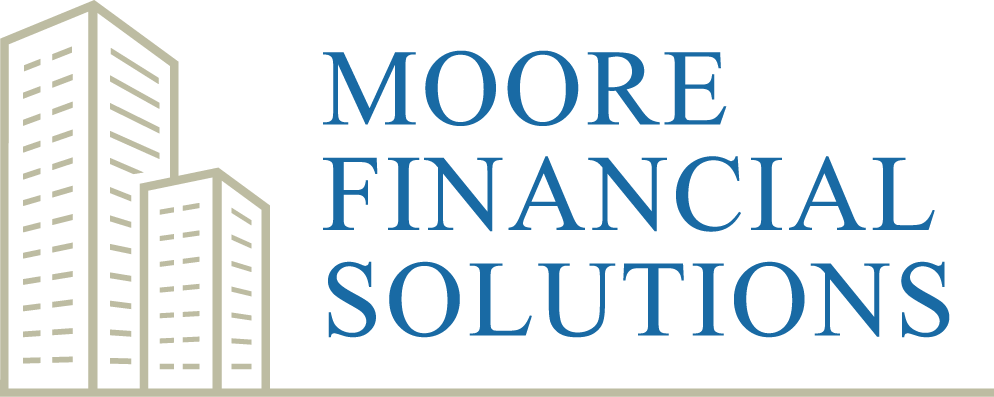Moore Financial Solutions First Quarter 2024
The exuberant party continued for equity investors in the first quarter of 2024 as Moore Financial Solutions clients again were rewarded for their holdings in equities (stocks). In our last quarterly review, we voiced confidence in equities stating, “Following a 20% or greater move in stocks, the market was up 22 of 34 of the following years, equating in a positive stock market return the following year occurring 65% of the time (1). We also stated that since 1952, the S&P 500 has averaged a 7% gain during U.S. presidential election years (2).” Our conversational benchmark, the S&P 500 climbed 10.158% in the first quarter of 2024, coming off of a 24.23% S&P 500 return for last year. This quick start to 2024 was a delightful surprise to many households owning stocks, and even a bit of a surprise to Wall Street, with few predicting such an immediately fruitful start to the year. We pridefully remained heavily allocated to high quality equities as they experienced their best Q1 start to a year since 2019. Take five minutes to review with us how we identify where we think exuberance ends and irrational exuberance starts, how just a handful of stocks have resulted in a major portion of overall gains, and how interest rates have remained higher than most predicted thanks to a sticky inflation problem.
While Q1 was not without worry, we felt strongly about the sentiment of U.S. equities. If you’ve read previous Moore F.S. reviews, you know we put a lot of value into Price to Earnings ratios. The P/E ratio will measure a company's share price relative to its earnings per share (EPS) and help to determine how much investors are willing to pay for a stock relative to the company’s earnings (3). The current April 1, 2024, P/E ratio of the S&P 500 is an estimated 27.19, higher than average (4). However, in our opinion this is no indication of pulling the sell lever on equities, as analysts expect overall S&P 500 earnings to rise 9.5% in 2024, after increasing around 4% the prior year (5). With every historical downturn in the S&P 500 having been overcome, we feel that investors unknowingly become more faithful in broad U.S. equities to recover after a downturn, thus naturally leading to a higher P/E ratio. For example, now that the S&P 500 has weathered 29 bear markets since 1928, investors likely feel better about their chances of a recovery now than they did during the first ever bear market. We feel that the “buy and hold” clients, similar to the average Moore F.S. client, tend to drag that P/E ratio upward as we’re more willing to pay for future earnings, and just patiently wait out any downturns. We believe the consumer has been incredibly resilient, even through interest rate increases designed to slow them down, and that earnings will continue their upward trend. If the S&P500 continues with approximately $190/yr of earnings it seems it can expand another 9% before we feel there is a truly overvalued feeling at a 30 P/E ratio.
Moore F.S. strategically uses Exchange Traded Funds (ETF’s) as opposed to mutual funds to give you an advantage of lower expense ratios. Where many firms you see advertised on T.V. simply move you over to a mutual fund for the management process, we specifically tune every portfolio, primarily with ETFs, hoping to avoid the high mutual fund expenses, often as high as 1% per year. However, there can be drawbacks or specific risks to ETFs, such as crowding into a small number of companies. For example, Microsoft is the largest holding within the S&P 500 representing approximately 7.23% compared to Mohawk Industries which represents only about .01% of the index (6). Thus, our largest holding, the Blackrock iShares Core S&P 500 ETF has approximately 723 times more weighting to Microsoft than Mohawk Industries. Furthermore, as your fiduciary we must strike a balance between riding the momentum wave of trends and moving away from them at the right time. “The Magnificent 7” is a nickname referring to seven of the technology giants that have far outperformed the rest of the broad market since the October 12th 2022 closing low price on the S&P 500 of 3,577.03 (7). Made up of Apple,
Google, Microsoft, Tesla, Nvidia, Facebook, and Amazon, The Magnificent 7 returned 112% in 2023, outpacing the S&P 500 index by nearly 90%, and just booked a 17% average return for the first quarter of 2024 beating the broad market by 7% (8). To tie things back into P/E ratios, on January 24th of this year J.P. Morgan discussed how The Magnificent 7 trades at a P/E multiple of 29x, compared to the 17x P/E multiple of the median S&P 500 stock (9). However, we feel this trend will not continue, and although we were early to the interest rate decrease party, we feel strongly that when rates fall this will allow companies that have been left behind the opportunity to catch up. If things continue on this trend we envision utilization of equal weighted funds, that in the example above would own Microsoft and Mohawk Industries in equal weighted percentages. For now, we feel the top-heavy usage of ETF’s stand to continue benefiting from the Artificial Intelligence boom discussed in our past quarterly reviews as Microsoft and Google benefit from A.I. implementation more than a construction/flooring company, for example.
Inflation isn’t just a main street problem, but rather a Wall Street problem as well. As mentioned in previous Moore F.S. reviews the average corporation’s bottom line can easily be eroded due to higher operating or input costs. Moreover, a higher interest rate environment typically leads to higher operating costs for a firm, as they typically choose to leverage debt for operations. Unfortunately, inflation isn’t ideal for stock market performance either, as the real return for stocks (the rate at which stocks produce gains above and beyond the current level of inflation) tends to be higher when inflation is only 2%-3% (10). We believe inflation has been far stickier than forecasted for a variety of factors. The two main factors include the economy simply being more resilient than anticipated and the elevated levels of interest income many Americans experience on their portfolios leading them to have more purchasing power.
Moore F.S. is always fine-tuning portfolios, this is an example of our fiduciary stance in continually managing your money to ensure it is invested in a prudent manner. Moore F.S. added a position of Natural Grocers (NGVC) stock in Q1 ’24. With the average family in America seeing their net worth increase 37% from 2019 to 2022 (11), we believe they give themselves permission to spend more. But with energy levels reelevating and stubbornly high interest and inflation rates, consumers must still be tactical in their budgets. While fast food lines will wrap around buildings until the end of time, consumers are trending towards finding more value in higher quality food, for example comparing the price of a home cooked meal to a Big Mac. Though Natural Grocers isn’t likely to be a direct replacement for McDonalds customers, we believe a shift will occur up the ladder of consumers. Additionally, many consumers are growing impatient with the FDA and EPA to protect their food, with approximately 72 types of pesticides in use in the USA that are banned in Europe, accounting for over 300 million pounds (approximately a quarter of our total usage) of pesticides applied to our soils that would be illegal in Europe. Moore F.S. added this position at $16.94 and we see this as a long-term position requiring years to recognize the full effect of this trend shift. NGVC closed the quarter at $18.05 but reached $19.35 intraday within Q1. NGVC is lightly traded, so will likely remain volatile. For this reason, the position is small, but it is an attempt to create portfolio alpha within your plan, much like Builders First Source (BLDR) has been. While high-end food products are by no means recession proof, we believe many Americans have shifted to real food consumption and will likely not shift back even in the event of a recession. Additionally, Natural Grocers appears to have top notch customer retention plans. Another notable change within Moore F.S. holdings include selling Apple (AAPL). While Moore F.S. has used Apple’s size and global dominance as somewhat of a lightly held core position (with the idea of Moore F.S. being tasked with portfolio management and providing you a small area of expense ratio free products) a complete sell was elected for all Moore F.S. clients at approximately 172.33 as the Justice Department sues Apple in complaint that Apple has a monopoly within smartphone markets (12). Apple closed the quarter at $171.48.
As we approach what appears to be another fruitful year within your portfolio, it remains my goal to personally manage every portfolio in a tactical and prudent manner. I view this year as pivotal regarding the economy’s ability to stand on its own while interest rates remain stubbornly high. While I began the year thinking the Federal Reserve would reduce interest rates three or four times within 2024, I’ve been humbled to hoping for one or two rate cuts. Regardless of the size and timing of interest rates, I feel the consumer is good and will continue to lead to strong stock market performance, with the occasion drawdowns as people take profits, a normal healthy function of the market. Every week we field calls regarding the strategy around interest rates and welcome all financial questions! I believe that if you have a good financial strategy, it can make your chances of success much greater in achieving your goals and am always eager to help you realize those goals. It is with great pride to be your fiduciary and together we make a strong team!

1. https://awealthofcommonsense.com/2023/12/what-happens-after-a-20-up-year-in-the-stockmarket/#:~:
text=The%20stock%20market%20was%20up,%2B18.8%25%20in%20up%20years.
2. https://money.usnews.com/investing/articles/election-2024-how-stocks-perform-in-election-years
3. https://www.investopedia.com/terms/p/price-earningsratio.asp
4. https://www.gurufocus.com/economic_indicators/57/pe-ratio-ttm-for-the-sp-500
5. https://www.reuters.com/markets/us/sp-500-end-2024-with-small-gain-after-strong-2023-2024-02-22/
6. https://www.slickcharts.com/sp500
7. https://www.barrons.com/livecoverage/stock-market-today-101223/card/today-marks-the-one-year-anniversary-of-the-s-p-500-s-
2022-closing-low-SUws7pzp4RJE3MMMtqIa
8. https://www.investopedia.com/is-the-ride-of-the-magnificent-seven-over-8608006
9. https://am.jpmorgan.com/us/en/asset-management/adv/insights/market-insights/market-updates/on-the-minds-of-investors/can-themagnificent-
7-retain-its-magnificence/
10. https://www.investopedia.com/articles/investing/052913/inflations-impact-stock-returns.asp
11. https://www.cnbc.com/2023/10/19/fed-survey-of-consumer-finances-net-worth-surged-in-pandemicera.
html#:~:text=Net%20worth%20for%20the%20typical,and%20pandemic%2Dera%20government%20stimulus.
12. https://www.justice.gov/opa/pr/justice-department-sues-apple-monopolizing-smartphone-markets
This material has been prepared for information and educational purposes and should not be construed as a solicitation for the purchase or sell of any investment. The content is developed from sources believed to be reliable. This information is not intended to be investment, legal or tax advice. Investing involves risk, including the loss of principal. No investment strategy can guarantee a profit or protect against loss in a period of declining values. Investment advisory services offered by duly registered individuals on behalf of CreativeOne Wealth, LLC a Registered Investment Adviser. CreativeOne Wealth, LLC and Moore Financial Solutions are unaffiliated entities.



